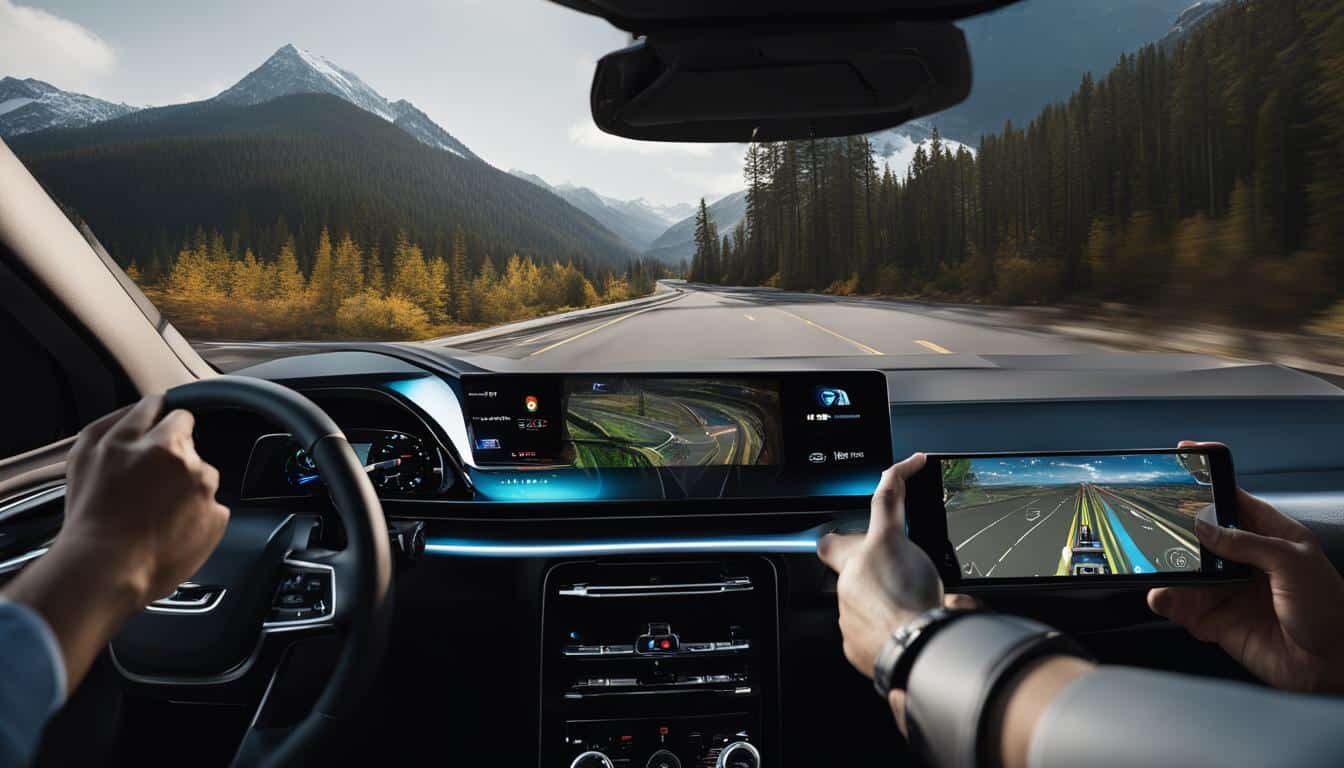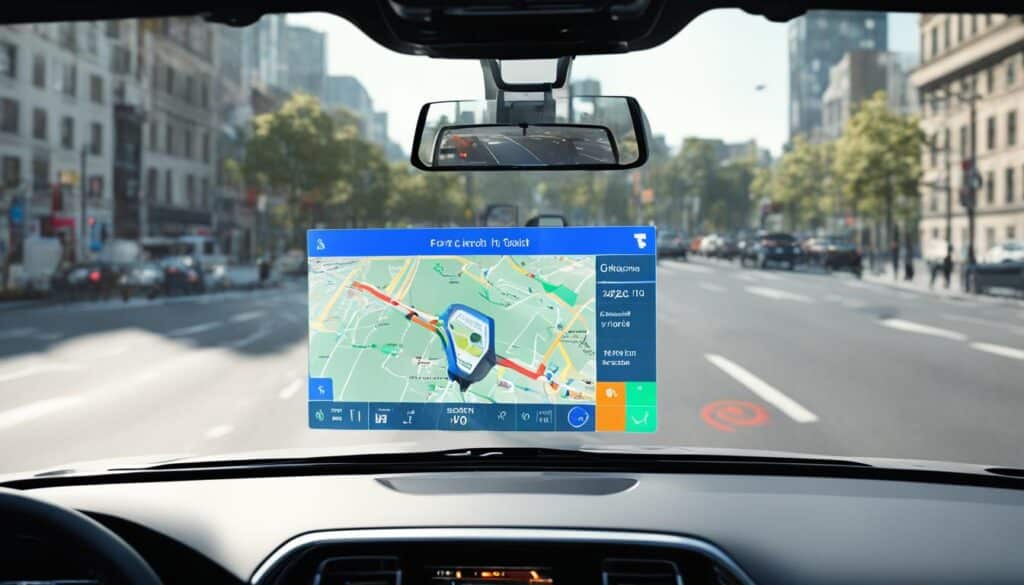
Augmented Reality in Navigation Systems: Enhancing the Driving Experience
Augmented reality is revolutionizing vehicle navigation systems, offering a new way to enhance the driving experience. By overlaying digital information onto the real-world view, augmented reality provides real-time guidance, improved safety, and increased situational awareness for drivers. This technology is gaining traction among automakers and is set to transform the way we navigate on the roads.
Key Takeaways:
- Augmented reality enhances vehicle navigation systems by overlaying digital information onto the real-world view.
- It provides real-time guidance and improved safety by eliminating the need to shift focus between a GPS device or smartphone and the road.
- Augmented reality enhances situational awareness by displaying relevant information directly in the driver’s line of sight.
- The implementation of augmented reality involves advanced technologies like GPS, sensors, and computer vision.
- The future prospects of augmented reality in vehicle navigation systems include more accurate integration and advanced features like augmented traffic signs and pedestrian detection.
The Advantages of Augmented Reality in Vehicle Navigation Systems
Augmented reality brings several advantages to vehicle navigation systems. Firstly, it provides real-time guidance by overlaying navigation instructions directly on the driver’s field of view. This eliminates the need to constantly shift focus between a GPS device or a smartphone and the road, reducing distractions and improving safety.
Additionally, augmented reality can enhance situational awareness by displaying relevant information such as traffic conditions, road hazards, and points of interest in the driver’s line of sight. This enables drivers to make informed decisions and navigate more efficiently.
Overall, augmented reality in vehicle navigation systems enhances the driving experience by providing convenient and accurate guidance while keeping the driver’s attention focused on the road.
| Advantages of Augmented Reality in Vehicle Navigation Systems |
|---|
| Real-time guidance directly in the driver’s field of view |
| Enhanced situational awareness with relevant information |
| Reduced distractions and improved safety |
| Efficient navigation and informed decision-making |
Implementation of Augmented Reality in Vehicle Navigation Systems
The implementation of augmented reality in vehicle navigation systems involves the integration of advanced technologies such as GPS, sensors, and computer vision. These technologies work together to track the vehicle’s position, orientation, and surroundings, enabling the augmented reality system to overlay digital information accurately. By utilizing markers and landmarks, the system aligns virtual information with the real-world view, ensuring precise and reliable guidance for drivers.
Automakers are actively incorporating augmented reality into their navigation systems to provide enhanced driving experiences. Some models already feature head-up displays that project navigation instructions onto the windshield, eliminating the need for drivers to look away from the road. This implementation reduces distractions and improves safety by keeping important information in the driver’s line of sight.
As technology continues to evolve, we can anticipate further advancements and seamless integration of augmented reality in vehicle navigation systems. The future holds tremendous potential for innovative developments that enhance the driving experience and provide drivers with real-time information and guidance.
Advantages of Implementing Augmented Reality in Vehicle Navigation Systems:
- Real-time guidance overlayed directly onto the driver’s field of view.
- Improved safety by reducing distractions and keeping the driver’s attention on the road.
- Enhanced situational awareness through the display of relevant information such as traffic conditions and road hazards.
- Efficient navigation and informed decision-making for drivers.

| Implementation Benefits | Explanation |
|---|---|
| Real-time guidance | Overlaying navigation instructions directly on the driver’s field of view reduces the need for additional devices and distractions while driving. |
| Enhanced safety | By reducing the need to shift focus between devices and the road, augmented reality minimizes distractions, increasing safety on the road. |
| Improved situational awareness | Augmented reality allows drivers to view relevant information, such as traffic conditions and points of interest, without taking their eyes off the road. This enhances their overall awareness and decision-making abilities while driving. |
| Precise and reliable guidance | The use of markers and landmarks in augmented reality systems ensures accurate alignment of virtual information with the real-world view, providing drivers with precise and reliable guidance throughout their journey. |
Future Prospects of Augmented Reality in Vehicle Navigation Systems
The future prospects of augmented reality in vehicle navigation systems are promising. As the technology advances, we can expect more accurate and seamless integration of digital information into the driver’s field of view. Augmented reality could evolve to support more advanced features such as augmented traffic signs, pedestrian detection, and road hazard warnings. Additionally, the development of smart glasses and heads-up displays specifically designed for automotive use could further enhance the augmented reality experience in navigation systems. With advancements in connectivity and 5G networks, augmented reality navigation systems could also leverage real-time data to provide up-to-date information and adaptive route planning. The future of augmented reality in vehicle navigation systems holds great potential for improving the driving experience and road safety.
Advancements in Augmented Reality Technology
The future of augmented reality in vehicle navigation systems depends on the continuous advancements in technology. As companies invest in research and development, we can expect significant improvements in accuracy, performance, and user experience. Some of the future advancements we may see include:
- Enhanced Object Recognition: Augmented reality systems could become more accurate in recognizing and identifying objects on the road, such as traffic signs, lane markers, and pedestrians. This would provide the driver with real-time information and warnings, improving safety and navigation efficiency.
- Real-time Traffic Data: With the integration of connectivity and 5G networks, augmented reality navigation systems could access real-time traffic data to provide up-to-date information on congestion, accidents, and road closures. This would enable drivers to plan their routes more effectively and avoid traffic delays.
- Intelligent Route Planning: Augmented reality systems could leverage artificial intelligence algorithms to analyze multiple factors such as traffic conditions, driver preferences, and road hazards to generate dynamic and adaptive route suggestions. This would provide drivers with the most efficient and safe routes based on real-time data.
- Enhanced User Interface: The user interface of augmented reality navigation systems could be further improved to provide a seamless and intuitive experience. Smart glasses and heads-up displays could offer a more natural and immersive interaction, allowing drivers to access information without taking their eyes off the road.
With these advancements, augmented reality in vehicle navigation systems has the potential to revolutionize the way we navigate on the roads. By providing real-time information, personalized guidance, and increased situational awareness, augmented reality can enhance the driving experience and contribute to improved road safety.

| Advantages of Future Augmented Reality Navigation Systems | Potential Benefits |
|---|---|
| Improved Safety | Real-time warnings for road hazards, pedestrians, and other potential dangers |
| Efficient Route Planning | Dynamic and adaptive routes based on real-time traffic data |
| Enhanced Situational Awareness | Overlay of relevant information on the driver’s field of view, reducing distractions and improving decision-making |
| Personalized Guidance | Customized route suggestions based on driver preferences and real-time conditions |
Conclusion
Augmented reality is revolutionizing vehicle navigation systems, enhancing the driving experience for motorists. By providing real-time guidance and overlaying digital information onto the real world, this technology offers several advantages including improved safety, increased situational awareness, and reduced distractions.
The implementation of augmented reality in vehicle navigation systems involves advanced technologies such as GPS, sensors, and computer vision. Automakers are actively adopting this technology, with some models already featuring head-up displays that project navigation instructions onto the windshield.
The future prospects of augmented reality in navigation systems are promising. As the technology continues to evolve, we can expect more accurate integration, advancements in accuracy, and the development of specialized hardware. With augmented reality becoming more seamless and advanced, it is poised to play an even greater role in enhancing the driving experience and improving road safety.
FAQ
What is augmented reality?
Augmented reality is a technology that overlays digital information onto the real-world view, enhancing the user’s perception and interaction with their environment.
How does augmented reality enhance vehicle navigation systems?
Augmented reality improves vehicle navigation systems by providing real-time guidance directly in the driver’s field of view, enhancing situational awareness, and reducing distractions.
What are the advantages of augmented reality in vehicle navigation systems?
The advantages of augmented reality in vehicle navigation systems include real-time guidance, improved safety, increased situational awareness, and reduced distractions.
How is augmented reality implemented in vehicle navigation systems?
Augmented reality in vehicle navigation systems is implemented through the use of advanced technologies such as GPS, sensors, and computer vision, which track the vehicle’s position, orientation, and surroundings to overlay digital information accurately.
What is the future outlook for augmented reality in vehicle navigation systems?
The future prospects of augmented reality in vehicle navigation systems are promising, with potential advancements in accuracy, integration, and the development of specialized hardware.
Source Links
- https://ai2.news/2024/01/10/at-ces-a-look-down-the-long-road-ahead-for-automotive-tech/
- https://anyuakmedia.com/the-importance-of-ai-in-enhancing-prestashops-mobile-experience/
- https://ai2.news/2024/01/10/deloitte-is-rolling-out-an-ai-chatbot-that-can-help-staff-answer-emails-and-create-presentations/
